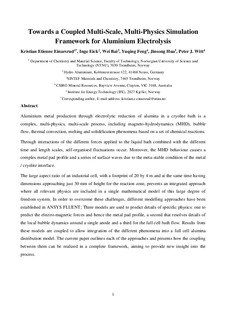| dc.contributor.author | Einarsrud, Kristian Etienne | |
| dc.contributor.author | Eick, Ingo | |
| dc.contributor.author | Bai, Wei | |
| dc.contributor.author | Feng, Yuqing | |
| dc.contributor.author | Hua, Jinsong | |
| dc.contributor.author | Witt, Peter J. | |
| dc.date.accessioned | 2018-03-07T11:42:42Z | |
| dc.date.available | 2018-03-07T11:42:42Z | |
| dc.date.created | 2017-01-06T13:26:46Z | |
| dc.date.issued | 2017 | |
| dc.identifier.citation | Applied Mathematical Modelling. 2017, 44 3-24. | nb_NO |
| dc.identifier.issn | 0307-904X | |
| dc.identifier.uri | http://hdl.handle.net/11250/2489215 | |
| dc.description.abstract | Aluminium metal production through electrolytic reduction of alumina in a cryolite bath is a complex, multi-physics, multi-scale process, including magneto-hydrodynamics (MHD), bubble flow, thermal convection, melting and solidification phenomena based on a set of chemical reactions. Through interactions of the different forces applied to the liquid bath combined with the different time and length scales, self-organised fluctuations occur. Moreover, the MHD behaviour causes a complex metal pad profile and a series of surface waves due to the meta-stable condition of the metal/cryolite interface. The large aspect ratio of an industrial cell, with a footprint of 20 by 4 m and at the same time having dimensions approaching just 30 mm of height for the reaction zone, prevents an integrated approach where all relevant physics are included in a single mathematical model of this large degree of freedom system. In order to overcome these challenges, different modelling approaches have been established in ANSYS® FLUENT®; Three models are used to predict details of specific physics: one to predict the electro-magnetic forces and hence the metal pad profile, a second that resolves details of the local bubble dynamics around a single anode and a third for the full cell bath flow. Results from these models are coupled to allow integration of the different phenomena into a full cell alumina distribution model. The current paper outlines each of the approaches and presents how the coupling between them can be realized in a complete framework, aiming to provide new insight into the process. | nb_NO |
| dc.language.iso | eng | nb_NO |
| dc.rights | Attribution-NonCommercial-NoDerivatives 4.0 Internasjonal | * |
| dc.rights.uri | http://creativecommons.org/licenses/by-nc-nd/4.0/deed.no | * |
| dc.title | Towards a coupled multi-scale, multi-physics simulation framework for aluminium electrolysis | nb_NO |
| dc.type | Journal article | nb_NO |
| dc.type | Peer reviewed | nb_NO |
| dc.description.version | submittedVersion | nb_NO |
| dc.rights.holder | © 2016 Elsevier Inc. All rights reserved. | nb_NO |
| dc.source.pagenumber | 3-24 | nb_NO |
| dc.source.volume | 44 | nb_NO |
| dc.source.journal | Applied Mathematical Modelling | nb_NO |
| dc.identifier.doi | 10.1016/j.apm.2016.11.011 | |
| dc.identifier.cristin | 1422369 | |
| cristin.unitcode | 7492,1,5,0 | |
| cristin.unitname | Materialprosessering | |
| cristin.ispublished | true | |
| cristin.fulltext | preprint | |
| cristin.qualitycode | 1 | |

